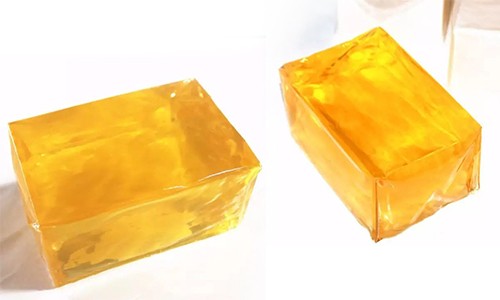
The performance of pressure-sensitive labels hinges critically on their adhesive. Various adhesive types are available in the market, including water-based, hot melt, solvent-based, removable, colored, and spacer adhesives. This article focuses on three widely used types: Hot Melt Adhesive, Water-Based Adhesive (often called "water glue"), and Solvent-Based Adhesive (commonly known as "oil glue").
1. Hot Melt Adhesive
Characteristics: Hot melt adhesives are rubber-based. They offer excellent flow properties, viscosity, and low-temperature application suitability (effective down to -5°C to -10°C), and are environmentally friendly and non-toxic. A key advantage is their ability to maintain good adhesion even on surfaces with trace oil or water contamination, outperforming water-based adhesives in such conditions.
Advantages:
Lower packaging and transportation costs.
No need for frozen storage, drying equipment, or drying processes.
Easy bonding to non-porous surfaces.
Rapid development of initial tack strength.
Good storage stability.
Forms a continuous film with water resistance and water vapor barrier properties.
Limitations:
Poor heat resistance, typically limited to temperatures below 70°C.
Temperature-sensitive during processing; becomes hard and brittle below 15°C in winter.
Poor repositionability.
Not suitable for PVC substrates or high-temperature labeling environments.
Typical Applications: Everyday consumer goods such as food, pharmaceutical, and supermarket labels.
2. Water-Based Adhesive (Water Glue)
Characteristics: Water-based adhesives primarily consist of acrylic polymers. They are cost-effective, generally non-toxic and odorless, and non-flammable. They offer a wide range of solids content and viscosity options.
Advantages:
Strong ultimate bond strength.
Generally superior heat resistance compared to hot melts; most withstand temperatures up to 90°C, with some specialized formulations tolerating around 150°C.
Limitations:
Poor low-temperature application performance.
Highly sensitive to surface contaminants like water or oil traces; even minor contamination significantly reduces adhesion.
Weak Initial Tack: Adhesion performance is moderate immediately after application. Requires a full curing cycle of approximately 24 hours to achieve optimal bond strength (due to slower flow properties needing time to fully wet the substrate surface).
Typical Applications: Labels for food, pharmaceuticals, personal care products, and some industrial labels requiring strict environmental compliance.
3. Solvent-Based Adhesive (Oil Glue)
Characteristics: Solvent-based adhesives utilize soft monomers like acrylic esters or vinyl acetate as the base material, curing and developing tack as the solvent evaporates. Compared to water-based adhesives, they offer superior water resistance and aging performance.
Advantages:
High bond strength (typically the strongest among the three), allowing repositioning.
Wide viscosity range.
Short curing time and low energy consumption.
Excellent film formation, durability, and water resistance.
Wide open time (working time).
High initial tack strength and fast grab.
Better adhesion than water-based adhesives to low-surface-energy (less polar), difficult-to-bond substrates like PP and PVC.
Limitations:
Relatively Poorer Environmental Performance: Solvents are volatile, often resulting in strong odors (intensity increases with lower solids content), and the adhesives are flammable. Some organic solvents (e.g., benzene derivatives) may have toxicity or irritant properties.
On non-porous, dense substrates, adhesive must be allowed to dry completely (solvent must evaporate) before bonding to avoid bubbling.
Typical Applications: Commonly used for labels on smooth surfaces like PP synthetic paper and PVC.
Summary & Key Points:
Adhesion Strength Comparison: Under equal adhesive thickness and substrate conditions, adhesion strength typically follows: Solvent-Based > Water-Based > Hot Melt. Pricing for these adhesives generally falls within a similar range.
Universal Requirement: Regardless of adhesive type, optimal labeling results demand a substrate surface that is clean, dry, and free of oil, grease, and dust. Label application should also occur in a dry environment.
 HOT LINE: 086-577-65159218
HOT LINE: 086-577-65159218












